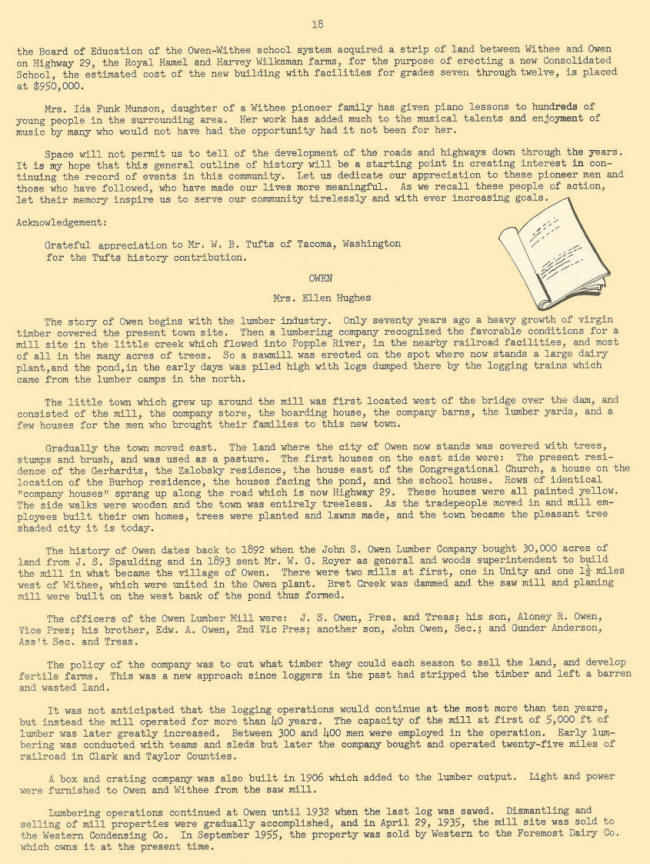|
[Memory
Trails Index]
Transcription
Janet Schwarze
the Board of Education
of the Owen-Withee school system acquired a strip of land between Withee and
Owen on Highway 29, the Royal Hamel and Harvey Wilksman farms, for the purpose
of erecting a new Consolidated School, the estimated cost of the new building
with facilities for grades seven through twelve, is placed at $950,000.
Mrs. Ida Funk Munson, daughter of a Withee pioneer family has given piano
lessons to hundreds of young people in the surrounding area. Her work has added
much to the musical talents and enjoyment of music by many who would not have
had the opportunity had it not been for her.
Space will not permit us to tell of the development of the roads and highways
down through the years. It is my hope that this general outline of history will
be a starting point in creating interest in continuing the record of events in
this community. Let us dedicate our appreciation to these pioneer men and those
who have followed, who have made our lives more meaningful. As we recall these
people of action, let their memory inspire us to serve our community tirelessly
and with ever increasing goals.
Acknowledgement:
Grateful appreciation to Mr. W. B. Tufts of Tacoma, Washington for the Tufts
history contribution.
OWEN
Mrs. Ellen Hughes
The story of Owen begins with the lumber industry. Only seventy years ago a
heavy growth of virgin timber covered the present town site. Then a lumbering
company recognized the favorable conditions for a mill site in the little creek
which flowed into Popple River, in the nearby railroad facilities, and most of
all in the many acres of trees. So a sawmill was erected on the spot where now
stands a large dairy plant, and the pond,in the early days was piled high with
logs dumped there by the logging trains which came from the lumber camps in the
north.
The little town which grew up around the mill was first located west of the
bridge over the dam, and consisted of the mill, the company store, the boarding
house, the company barns, the lumber yards, and a few houses for the men who
brought their families to this new town.
Gradually the town moved east. The land where the city of Owen now stands was
covered with trees, stumps and brush, and was used as a pasture. The first
houses on the east side were: The present residence of the Gerhardts, the
Zalobsky residence, the house east of the Congregational Church, a house on the
location of the Burhop residence, the houses facing the pond, and the school
house. Rows of identical “company houses” sprang up along the road which is now
Highway 29. These houses were all painted yellow. The side walks were wooden and
the town was entirely treeless. As the trade people moved in and mill employees
built their own homes, trees were planted and lawns made, and the town became
the pleasant tree shaded city it is today.
The history of Owen dates back to 1892 when the John S. Owen Lumber Company
bought 30,000 acres of land from J. S. Spaulding and in 1893 sent Mr. W. G.
Royer as general and woods superintendent to build the mill in what became the
village of Owen. There were two mills at first, one in Unity and one 1* miles
west of Withee, which were united in the Owen plant. Bret Creek was dammed and
the saw mill and planing mill were built on the west bank of the pond thus
formed.
The officers of the Owen Lumber Mill were: J. S. Owen, Pres. and Treas; his son,
Aloney R. Owen, Vice Pres; his brother, Edw. A. Owen, 2nd Vice Pres; another
son, John Owen, Sec.; and Gunder Anderson, Ass't Sec. and Treas.
The policy of the company was to cut what timber they could each season to sell
the land, and develop fertile farms. This was a new approach since loggers in
the past had stripped the timber and left a barren and wasted land.
It was not anticipated that the logging operations would continue at the most
more than ten years, but instead the mill operated for more than 4O years. The
capacity of the mill at first of 5,000 ft of lumber was later greatly increased.
Between 300 and 1400 men were employed in the operation. Early lumbering was
conducted with teams and sleds but later the company bought and operated
twenty-five miles of railroad in Clark and Taylor Counties.
A box and crating company was also built in 1906 which added to the lumber
output. Light and power were furnished to Owen and Withee from the saw mill.
Lumbering operations continued at Owen until 1932 when the last log was sawed.
Dismantling and selling of mill properties were gradually accomplished, and in
April 29, 1935, the mill site was sold to the Western Condensing Co. In
September 1955, the property was sold by Western to the Foremost Dairy Co. which
owns it at the present time.
[Next]
[Memory
Trails Index]
|
